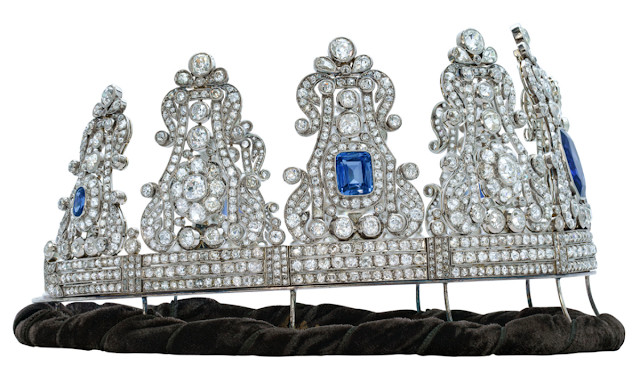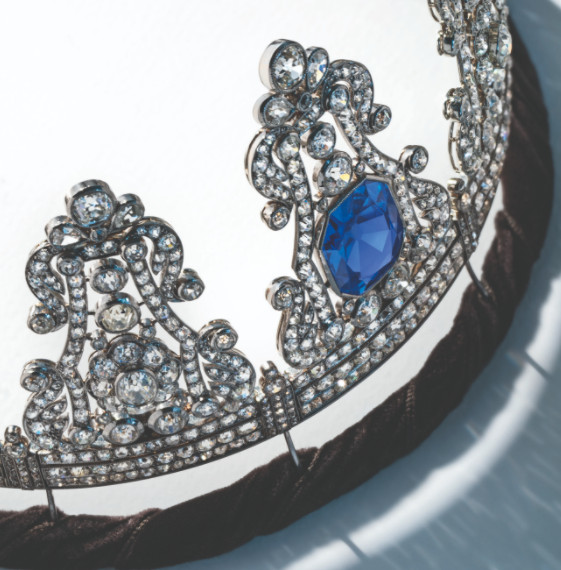 |
| Christie’s |
Yesterday, we chatted about a lovely suite of diamond and sapphire jewels being sold at Christie’s this month. Today, we’ve got another piece of royal jewelry being offered at the same auction by the same former royal family: the grand diamond and sapphire tiara that belonged to Queen Maria II of Portugal.
 |
| Queen Maria II’s sapphire and diamond tiara (Christie’s) |
The lot notes from the Christie’s website list the jewel as an “important 19th century sapphire and diamond crown.” I quibble a bit with the use of the word “crown” to describe this piece—I tend to agree with definitions of that word that are restricted to ornaments that are part of state regalia, often used for coronations. I think this piece is better described as a diadem or a large tiara. It’s big, and part of the base is a complete circlet, but I think the term “tiara” is a better descriptor here.
 |
| Queen Maria II of Portugal is depicted wearing the tiara, ca. 1846 (Wikimedia Commons) |
The tiara, though, did belong to a royal woman who was a reigning monarch. Queen Maria II was the eldest daughter of Emperor Pedro I of Brazil. Maria’s path to the throne was complicated. When her grandfather, King Joao VI, died in 1826, there were serious disagreements about who his successor should be. Joao’s elder son (and Maria’s father), Pedro, was already reigning on the throne of Brazil. Joao’s younger son, Prince Miguel, had been exiled for his role in a revolt two years earlier. Pedro decided to pass the Portuguese crown to his daughter, Maria, abdicating in her favor. Pedro and Miguel’s sister, Isabel Maria, was named regent for the young Queen Maria II, who was only seven years old. To satisfy Miguel and his supporters, it was decided that when she came of age, Maria II would marry her uncle Miguel. Eventually, Pedro decided to name Miguel as Maria’s regent, too.
In a move that probably shouldn’t have shocked anyone, Miguel took the regency opportunity to seize the throne for himself. He declared himself king in 1828, kicking off a war-torn reign that lasted until 1834, when he was exiled again and Maria II was restored to the throne. Thankfully, the marriage plan was ended, too. Queen Maria II married twice. Her first husband was Prince Auguste, 2nd Duke of Leuchtenberg (son of Eugene de Beauharnais and Augusta of Bavaria—and, interestingly, the baby whose birth inspired the gift of the Leuchtenberg sapphires). After Auguste’s premature death, Maria married Prince Ferdinand of Saxe-Coburg and Gotha (a first cousin of Queen Victoria and Prince Albert). Per Portuguese royal tradition, he was elevated to the title of King Ferdinand II after the birth of their son and heir, Pedro, in 1837.
 |
| Winterhalter’s portrait of Infanta Antonia, ca. 1866 (Wikimedia Commons) |
Queen Maria II and King Ferdinand II reigned jointly for the rest of her life, which was occupied in large part by difficult pregnancies and births. She died giving birth to her eleventh child, Infante Eugenio, in 1853. Seven of her children survived her, and her grand jewels were divided among them in roughly equal portions. This diamond and sapphire diadem was bequeathed to her fifth child, Infanta Antonia, who married Prince Leopold of Hohenzollern in 1861. They had three sons, one of whom was King Ferdinand of Romania. (Huge thanks to one of our readers, Portuguese royal jewelry enthusiast Arrigo, for sharing some of his research on the chain of ownership with me!)
 |
| Prince William of Hohenzollern with his second wife, Princess Adelgunde of Bavaria, ca. 1917 (Wikimedia Commons) |
The sapphires were inherited by Leopold and Antonia’s eldest son, Prince William of Hohenzollern. (He also inherited the Baden sapphire parure we discussed yesterday.) The tiara has stayed with the family in the years since. Prince William’s daughter-in-law, Princess Margarete Karola of Saxony, was photographed wearing the jewel in a formal portrait. She also wore it during the celebrations of the wedding of her son, Prince Johann Georg of Hohenzollern, to Princess Birgitta of Sweden in 1961. Birgitta also wore the tiara, including an appearance in the jewel at the royal wedding of her cousin, Queen Margrethe II of Denmark, in 1967. (You’ll note that Birgitta is also wearing the earrings, necklace, and one of the brooches from the Baden sapphire suite.)
 |
| A side view of the tiara (Christie’s) |
Now, the tiara is being offered for sale at Christie’s in Geneva. They describe the tiara simply as being made of gold and set with “octagonal step-cut and oval-shaped sapphires” and “varied old-cut diamonds.” They note that the tiara was made in the 1840s, during Queen Maria II’s second tenure as Portugal’s queen regnant. To me, the design of the piece shares significant similarities with the original Cambridge Sapphire Tiara.
 |
| The top elements from the tiara, removed and arranged as separate ornaments (Christie’s) |
The photos from the auction house also show the versatility of the jewel. The top portions of the tiara can be taken off the frame, forming nine individual sapphire and diamond ornaments.
 |
| The diamond base of the tiara (Christie’s) |
The base of the tiara, with its trefoil embellishments, can be worn separately as a much smaller bandeau-style tiara.
 |
| Christie’s |
The tiara will be sold by Christie’s in Geneva on May 12. Rumor has it that the Portuguese government is keen to acquire the piece and reunite it with other historic royal jewels from the nation. The auction estimate for the royal jewel is set at between $186,000-380,000 USD.
Leave a Reply